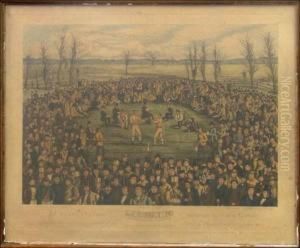J.B. Rowbotham Paintings
James Brereton Rowbotham, often recognized by his initials J.B. Rowbotham, was an English landscape painter born in 1853 in Sheffield, England. He was part of the Rowbotham family of artists, which included his father Thomas Charles Leeson Rowbotham and his brother Thomas Charles Rowbotham, both of whom were also respected artists in their own rights. This artistic lineage provided J.B. Rowbotham with a rich environment that nurtured his developing talents from a young age. Despite the overshadowing fame of his father and brother, J.B. Rowbotham managed to carve out his own niche in the English art scene of the late 19th and early 20th centuries.
Rowbotham's work primarily focused on landscapes, capturing the serene beauty of the English countryside as well as scenes from his travels abroad. His paintings are characterized by their detailed rendering, vibrant colors, and the ability to capture the changing effects of light on the landscape, a testament to his skill in observing and translating nature onto the canvas. He was particularly adept at watercolor, a medium that allowed him to express the subtleties of light and color in his landscapes, though he also worked in oils.
J.B. Rowbotham exhibited his work at various prestigious venues, including the Royal Academy and the Royal Society of British Artists, reflecting his recognition and respect within the art community. Despite this, he never quite achieved the same level of fame or critical acclaim as some of his contemporaries. His work, however, has continued to be appreciated for its technical skill and tranquil beauty, and his paintings are sought after by collectors of Victorian and Edwardian art.
Rowbotham's artistic contributions were part of the broader movement of landscape painting in England, which saw a surge in popularity during the 19th century. He captured the essence of the British landscape at a time of significant change and modernization, providing a window into a world that was rapidly evolving. His legacy, though perhaps not as widely recognized as that of some of his peers, remains an important part of the tapestry of English art history.
J.B. Rowbotham passed away in 1926, leaving behind a body of work that continues to be admired for its beauty and technical proficiency. His paintings serve not only as artistic achievements but also as historical documents, preserving the picturesque landscapes of his time for future generations to appreciate.
